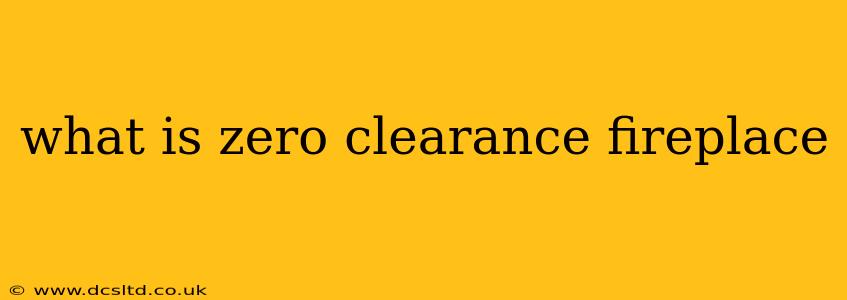A zero clearance fireplace, also known as a factory-built fireplace, is a prefabricated fireplace unit designed for installation with minimal clearance to combustible materials. Unlike traditional masonry fireplaces that require significant space between the firebox and surrounding walls, zero clearance fireplaces have a built-in fire-resistant enclosure, allowing for installation directly against a wall or even in a corner, saving valuable space and offering greater design flexibility.
This guide delves deep into the features, benefits, drawbacks, installation, and maintenance of zero clearance fireplaces, answering many frequently asked questions.
What are the Advantages of Zero Clearance Fireplaces?
Zero clearance fireplaces offer a compelling array of benefits:
-
Space Saving: Their primary advantage is their space-saving design. They can be installed virtually anywhere, maximizing usable floor space compared to traditional masonry fireplaces.
-
Cost-Effective: While the initial purchase price might be higher than a simple masonry fireplace shell, the overall cost, including installation and materials, is often comparable or even lower due to the reduced labor involved in construction.
-
Ease of Installation: The prefabricated nature of these fireplaces makes installation significantly faster and easier, often requiring less specialized labor.
-
Improved Efficiency: Modern zero clearance fireplaces are designed for improved efficiency, using less fuel and generating more heat than older masonry fireplaces. Many models include features like blower systems to distribute heat more effectively throughout the room.
-
Variety of Styles and Finishes: Manufacturers offer a wide variety of styles, finishes, and sizes to match different tastes and home décor styles, from sleek modern designs to traditional aesthetics.
What are the Disadvantages of Zero Clearance Fireplaces?
While offering many advantages, it's crucial to be aware of potential drawbacks:
-
Limited Customization: Compared to masonry fireplaces, customization options are more limited. You're generally choosing from a manufacturer's pre-designed models.
-
Potential for Damage: While designed to be highly fire-resistant, improper installation or maintenance can still lead to damage or fire hazards. Professional installation is strongly recommended.
-
Repair Challenges: Repairs can be more complex and expensive compared to masonry fireplaces, often requiring replacement of entire components rather than simple repairs.
-
Heat Distribution: While modern models improve heat distribution, they might not provide the same radiant heat as a large masonry fireplace.
How Much Does a Zero Clearance Fireplace Cost?
The cost of a zero clearance fireplace varies greatly depending on factors such as size, features (e.g., blower, venting system), style, and brand. Prices can range from a few hundred dollars for a basic model to several thousand dollars for high-end units with advanced features. It's vital to get multiple quotes from different suppliers before making a purchase.
How is a Zero Clearance Fireplace Installed?
Installation should always be done by qualified professionals adhering to local building codes and manufacturer's instructions. Improper installation can compromise safety and void warranties. The installation process generally involves:
- Selecting the Location: Ensuring appropriate clearances are maintained.
- Preparing the Opening: Cutting the opening in the wall to precisely match the fireplace dimensions.
- Installing the Fireplace Unit: Securing the unit firmly and correctly connecting the venting system.
- Connecting the Venting: This is a crucial step that must be done correctly to ensure safe exhaust of combustion gases.
- Inspection: A final inspection ensures compliance with safety regulations.
How Do I Maintain a Zero Clearance Fireplace?
Regular maintenance is essential for extending the lifespan and ensuring the safe operation of your zero clearance fireplace. Maintenance tasks include:
- Regular Cleaning: Cleaning the interior firebox, glass, and ash removal after each use.
- Inspecting the Venting: Regularly check the venting system for obstructions or damage.
- Annual Inspection: Consider a professional inspection annually to identify any potential issues.
What are the Different Types of Zero Clearance Fireplaces?
Zero clearance fireplaces come in various styles, including:
- Direct Vent: These fireplaces vent directly outdoors, eliminating the need for a chimney.
- B Vent: These use a double-wall venting system to exhaust fumes safely.
- Gas: These use natural gas or propane as fuel, offering a convenient and clean burning option.
- Electric: Electric zero clearance fireplaces are a more energy-efficient alternative and do not require venting.
- Wood Burning: Traditional wood-burning models that offer a classic fireplace experience.
Choosing the right zero clearance fireplace depends heavily on your specific needs, budget, and local building codes. Careful consideration of these factors ensures a safe and efficient addition to your home. Always consult with a qualified professional before making a purchase and proceeding with installation.
